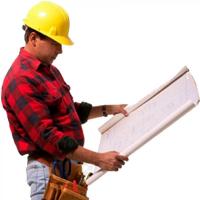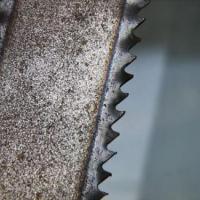Cutting the Confusion on Setting Bandsaw Blade Tension
by Guest Post on Apr 18, 2013
Every woodworker will have a unique method for determining the correct blade tension on a bandsaw. Some may rely on sight or even sound to check that they have the correct setting, and others will use expensive equipment to get an accurate reading.
Attempting to saw a piece of dense material with an incorrectly calibrated blade could result in an uneven finish, and possibly ruin many hours of work. To avoid this it is essential to check that your bandsaw is set to the correct tension for the thickness of the blade, and some methods employed by other workers may prove inaccurate.
A beautifully crafted piece of wood requires skill and reliable tools, so by making sure your machinery is properly set to the task in hand, you will be able to continue your work with confidence.
Don’t Play It By Ear
For those with pitch-perfect hearing, it is possible to judge the tension by plucking the blade and listening to the tone it emits. Whilst impressive, this is not an accurate way to gauge tension and could result in uneven edges or even a snapped blade. Others will simply adjust the tension until the saw feels comfortable, and use the same tension setting for many different types of wood. This can give unpredictable results as materials of different densities require specific tension settings.
It is important to remember that you only need to set the blade to maximum tension if you will be sawing very thick or dense wood and that it is advisable to relax the tension when it is not in use.
The Right Tools For The Job
The only way to accurately determine blade tension is to invest in a tension meter. These are handheld devices that work by gripping onto the blade and measuring the tension using a system of rollers. Whilst the models from well-known brands can be expensive, it is possible to pick up secondhand or cheaper models on sites such as eBay. If you cannot find a tension meter within your price range, there are other methods you could try. Once the blade is securely in place, move the guide blocks out of the way and push against the side of the blade.
Begin to tighten it in small increments using the tensioning knob until it moves no more than a ¼ inch when depressed. When using this method it is advisable to perform a trial run with a piece of scrap wood to ensure it is correctly calibrated for your chosen project.
What Does It Say On The Box?
The majority of blade manufacturers recommend a tension setting of 15,000 psi to 20,000 psi based on a regular carbon steel blade. This varies widely when using blades of different materials, and a carbide-tipped blade will command a tension setting of up to 30,000 psi. If you are using a large industrial bandsaw it will most likely have blade tension scales built-in.
Unfortunately, these are often faulty and will regularly show tension readings that are much higher than the blade is calibrated to. To compensate for this inaccuracy, set the tension for the blade you are using to the recommended settings of the next widest blade. When adjusting the tension it is important to work slowly and avoid over-tightening. If a blade snaps during sawing it can have disastrous consequences and could result in injury to yourself and expensive damage to your bandsaw.
Popular Articles
Three Places to Spend Money on the Exterior of Your Home
When you have the exterior of your home remodeled, you are investing, time, energy and convenience into the project and you want to make sure that...
104800 Views
Homemade Headboards-Make an Upholstered or Wooden Headboard
Homemade headboards can add a lot of personality to any bedroom. They can be coordinated with existing furniture and room decor or they can be the...
80088 Views
When to Use a Brush, Roller or Sponge Brush
Brushes are a good choice for painting trim and woodwork. They are also useful for cutting in the edges around the top and bottom edges and corners...
72750 Views
Creating a Cottage Kitchen with Bead Board
Kitchen decor can range from modern and bold to elegant and elaborate by using strategic kitchen pieces. One of the most popular decorating trends...
58515 Views
Gas Fireplace Diagnostics and Troubleshooting
Follow these steps for diagnosing and troubleshooting Gas Fireplaces repairs. For the average DIYer, this may seem intimidating, depending on the...
35558 Views
Latest Articles
How Much Does it Cost to Take A Bath?
Plumbers know that a bath may seem like a relaxing luxury, but the real cost extends far beyond your water bill. The average soak uses 35 to 50...
on Apr 8, 2025
10 Concrete Patio Ideas on a Budget
A concrete patio can be a game-changer for your outdoor space. It is durable, versatile, and can be customized to fit your style. But what if you...
on Mar 25, 2025
Tips for Creating a Stunning Personalized Photo on Canvas
Order the unique beauty of a personalized photo on canvas and bring your memories to life. With a customized photo on canvas, you can transform...
on Mar 7, 2025
Best Areas to Buy Property in Singapore for Long-Term Growth
Singapore's real estate market remains one of the most stable and lucrative in the world. With limited land supply, strong governmental...
on Feb 18, 2025
Troubleshooting Excess Water in Your HVAC Secondary Condensate Drain Pan
When maintaining your air conditioning system, it is easy to overlook the condensate drain pan - until excess water starts pooling in places where...
on Jan 12, 2025
Featured Articles
What Type of Licensed Contractor Should You Hire?
on Feb 28, 2017
Hire Contractors / Estimates

Looking for a specialty project? There are many types of contractors available for your home improvement needs. Finding the right type of...
Sponsored Articles
Best Areas to Buy Property in Singapore for Long-Term Growth
on Feb 18, 2025
Real Estate / Finance

Singapore's real estate market remains one of the most stable and lucrative in the world. With limited land supply, strong governmental...
Actions
Top Categories
- Garden / Landscaping / Patio — 264
- Kitchen / Bathrooms — 240
- Real Estate / Finance — 203
- Appliance / Repair — 186
- Interior Design / Decor — 184
- HVAC / Air Conditioning — 148
- Cleaning / Maintenance — 144
- Improvements / Remodeling — 131
- Plumbing / Basements — 118
- Floors / Tile / Hardwood — 116
- Doors / Garages — 113
- Safety / Security — 113
Articles Archive
More DIY Articles
7 Tips for Prolonging the Lifespan of Home Electrical Appliances
We all use various home electrical appliances such as washing machines, dishwashers, ovens, clothes dryers and HVAC systems. When appliances break...
Outdoor Blinds: 9 Reasons Why You Must Pick Them
Have you recently moved into your new home and are looking for ways to spruce up the place? While many homeowners focus on beautifying their home...
6 Ways You Can Spruce Up Your Kitchen on a Budget
An attractive and healthy-looking kitchen is one of the most striking spaces in the home. The condition of your kitchen can add to or subtract from...
Finding a Good HVAC Contractor Near You
Icy winters, hot summers, humidity, cloudiness, and fluctuations in temperature are phrases and words that are often used to describe the climate...
How to Remove Calcium Deposits from a Showerhead
Hard water can wreak havoc on your faucets and showerheads. Over time, calcium build-up can actually block your showerhead that can really ruin...

